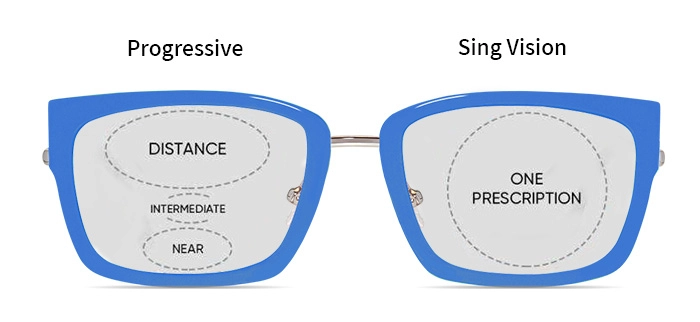Single Vision vs. Progressive Lenses: Key Differences, Pros, and Cons
When choosing eyeglasses, understanding the difference between single vision and progressive lenses is essential. Single vision lenses address one focal point, ideal for correcting nearsightedness or farsightedness, while progressive lenses provide a seamless transition for multiple vision needs. This article explores their pros, cons, and the best use cases to help you make an informed decision.

What Are Single Vision Lenses?
Single vision lenses are designed to correct one vision field—either distance or near vision. They are commonly used for reading glasses and distance glasses.
How Single Vision Lenses Work
- Lens Thickness: Nearsighted lenses are thicker at the edges, while farsighted lenses are thicker in the center.
- Applications: Useful for those with a specific vision issue, such as difficulty reading or seeing distant objects.
Advantages of Single Vision Lenses
- Cost-Effective: These lenses are generally more affordable than progressive lenses.
- Lightweight Design: Easier to handle, especially for low-prescription users.
- Customizable for Specific Needs: Suitable for close-up tasks or distance vision.
Disadvantages of Single Vision Lenses
- Limited Functionality: Only corrects one type of vision, requiring multiple pairs of glasses for different tasks.
- Increased Costs for High Prescriptions: Thicker lenses may need high-index upgrades, adding to the cost.
- Potential for Eye Strain: Frequent switching between glasses can be inconvenient and tiring.
What Are Progressive Lenses?
Progressive lenses provide a smooth transition between multiple vision zones—near, intermediate, and far—without visible lines like bifocals or trifocals.
How Progressive Lenses Work
- Gradual Power Shift: Lens power gradually changes from the top to the bottom of the lens, accommodating different focal points.
- Multi-Purpose Use: Ideal for individuals with presbyopia who need assistance with both near and far vision.
Advantages of Progressive Lenses
- All-in-One Solution: Eliminates the need for multiple pairs of glasses.
- No Visible Lines: Offers a sleek, modern appearance without the bifocal line.
- Enhanced Comfort: Provides a natural transition between various vision zones.
Disadvantages of Progressive Lenses
- Higher Cost: Advanced technology and customization make them more expensive.
- Adjustment Period: Users may need time to adapt to the lens transitions.
- Not Perfect for All Tasks: May not provide optimal clarity in specific regions of the lens, especially for detailed tasks.
Single Vision vs. Progressive Lenses: A Side-by-Side Comparison
| Feature | Single Vision Lenses | Progressive Lenses |
|---|---|---|
| Vision Correction | One focal point (near or far) | Multiple focal points (near, intermediate, far) |
| Appearance | Simple design | Sleek with no visible lines |
| Cost | Affordable | More expensive |
| Functionality | Specific tasks | Versatile for various tasks |
| Adjustment Required | Minimal | Moderate |
Which Lens Type Is Right for You?
Choose Single Vision Lenses If:
- You only need correction for a single vision issue, like nearsightedness or farsightedness.
- You are on a budget and prefer a simpler solution.
Choose Progressive Lenses If:
- You need correction for multiple vision ranges (e.g., presbyopia).
- You want a seamless, modern look without bifocal lines.
Both single vision and progressive lenses offer unique benefits. Your choice should depend on your vision needs, lifestyle, and budget. Consult with your optometrist to determine the best option tailored to your requirements.
Share this post
Varifocal Lenses: How They Work, Benefits, and Drawbacks
Varifocal lenses, also known as progressive lenses, provide seamless vision correction for various distances. They eliminate the need for multiple pairs of...
Lenses And Coatings
At XCombo.com, we are committed to providing high-quality prescription lenses tailored to every pair of frames you purchase. Our affordable and reliable...
Understanding CYL, AXIS, and SPH in Eye Prescriptions
When you receive an eye prescription, you may notice terms like CYL, AXIS, and SPH. These are essential measurements that help determine...
Blue Light Blocking Lens
Blue-ray exists everywhere todayWith the widespread use of electronic screens, more people suffer from eyestrain symptoms when using electronic devices. One of...
Trivex Lenses Explained: Differences, Advantages, and Considerations
Trivex lenses have gained significant attention in the eyewear industry as an advanced alternative to traditional lenses. Known for their durability, lightweight...
